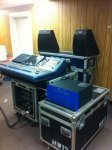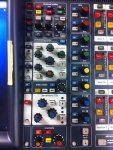Re: Midas Pro 2
Hey Brandon, any gigs with this thing, or any other comments on it... very interested in knowing it's pitfalls, build quality etc... Also if you have any hi-res photos you could share, especially of the right hand side ( looking at it)...channel strip section... there doesn't seem to be much of that online to look at.
thx
We had a demo of the Pro2 the shop last week, here are my impressions:
Build quality is superb. All the components seem to be the same as on the PRO3/6/9 and XL8, there are just fewer of them. The faders are some of the nicest motorized faders you can get, all of the knobs have a pleasurable weighty feel to them, nearly every switch has a LED indicator that shows you the current status at a glance. The chasis is all metal and uses neutrik connectors throughout, and the flight case is top notch with an integrated keyboard tray. The only negative thing I noticed is the trackball on our demo model was a little "sticky" and it did make selecting on screen parameters a little difficult. This is a fairly big problem as you cannot really use the console without the screen. I ended up plugging in a Logitech trackball and using that instead.
Operating the console is easy once you get the hang of the way it operates. If you're used to a Avid desk, you'll probably be off to a faster start than if you're more familiar with a touchscreen driven system. If you've run a Midas digital console before, you'll be right at home with the UI, as it operates much in the same way as it does on the bigger consoles. Unlike the bigger consoles, since there is only one screen when you're adjusting your FX or graphics, patching, working in the sceen manager, or doing any setup or configuration, you loose the ability to see the parameters you're adjusting on the channel strip. If you want to see your selected channel "detail strip", you need to hit the "console overview" button, which of course will take the display out of whatever other page you were just in. This is just one example of several compromises that Midas had to make in order to hit the price point and format. Overall it does have some awkward behaviors that result in some moments of "wait what?" and not every function is as easy to find for a novice user might like. It took me about 10 minutes and a trip to the manual before I figured out how to reconfigure my buses back to mono aux sends from stereo groups.
You get six internal effects units, all of which sound excellent but do share DSP resources with the graphics, so you do have to sacrifice EFX units if you need more than 8 graphics. Each EFX unit you gives up makes room for four channels of graphics. Adjusting graphics is not the simplest procedure and either requires scrolling around on the bank of 8 VCA faders, or using the rotary controllers beneath the display. Neither method is particularly fast requires a series of button presses or navigating around on the display to get to. Beyond ringing the system out during sound check, I wouldn't want to rely on the on console methods for adjusting EQ on multiple mixes or while under fire. The Rapide would be a must have add-on for this console if you're using it for monitors.
Adjusting EQ on the channel strip is very fast despite only having three physical knobs and paging around on your selected filter is fast and ergonomic. In addition to the two parametric mid-band filters, you get a bass and treble filters which are selectable parametric or several types of shelving. The input compressor is also very fast and easy to use, with all the familiar parameters within easy grasp. There are several selectable modes of operation as well as three knee types. Metering is OK, but I would have preferred a more traditional Input/Output/GR set of meters instead of the fancy meter on the graph. Other channel strip features sweepable hi pass/lo pass with adjustable slope (2nd/4th order on the HP, 1st/2nd on the LP), full featured gate with external sidechain, LCR panning, and switches for all other important channel functions.
VCA's, POP groups, and MCA's are what really makes this console fast to use once you're all set up. MCA's are the new feature on this console and as far as I can tell, it's unique to this desk. Basically it's another set of 8 VCA's specific to each bus. From a monitor console perspective, this makes it extremely powerful. Let's say your keyboard player requests less guitars, more brass, and less lead vocal. Traditionally this would mean adjusting the send on each guitar channel, each brass channel, and the lead vocal channel, but on the Pro2 it means you can just select the mix, hit the MCA button to put the VCA faders into MCA mode, and just pull down the GTR and L VOX faders and bump up the BRASS fader. Send levels will change only for that selected mix. When you're not in MCA mode, changes to a VCA behave just like they would on a traditional digital or analog console, and levels will change in every mix. Another thing not really made obvious is that though there are 16 aux buses, (these can also be mono or stereo groups), the additional 8 matrix buses can pull directly from the input channels and function as additional monitor mixes.
Automation is top notch, even though I only had a few minutes to play with it. It is easy to use, fast, responsive, and just works like it should. This console should end the reign of the M7CL in smaller community theaters.
As far as pitfalls, there are many. One one that stuck out at me is that because it only uses AES50 for it's "digital snake" and not HyperMAC like it's bigger brethren, it does require a minimum of 2x CAT5e to the stagebox for full operation, and you're encouraged to run N+1 for a total of 3x CAT5e. There is also no ethernet tunneling in this configuration, so if you have any additional on stage gear, you're looking at a total of 4x CAT5e runs to the stage. This just isn't as convenient as two single cables with eight times the overall capacity AND full redundancy. The control surface and UI are also very cluttered, with lots of small switches and buttons *everywhere*. It is a little intimidating when you first walk up to it and as I said above not every function in the UI is clear in its function. Having the manual nearby is likely going to be a requirement for anyone new on the console.
Despite it's drawbacks, there is something special about this console that I have a hard time quantifying. Once you get used to the way it operates, it just feels nice to use and that's not something I can really explain in words. Find a way to get your hands on one and set aside few hours to really get to know it, and you'll know what I mean.


